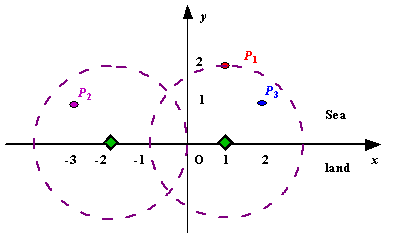| Time Limit: 1000MS | Memory Limit: 10000K | |
| Total Submissions: 55428 | Accepted: 12481 |
Description
We use Cartesian coordinate system, defining the coasting is the x-axis. The sea side is above x-axis, and the land side below. Given the position of each island in the sea, and given the distance of the coverage of the radar installation, your task is to write a program to find the minimal number of radar installations to cover all the islands. Note that the position of an island is represented by its x-y coordinates.

Figure A Sample Input of Radar Installations
Input
The input is terminated by a line containing pair of zeros
Output
Sample Input
3 2 1 2 -3 1 2 1 1 2 0 2 0 0
Sample Output
Case 1: 2 Case 2: 1
题意:
在以X轴为海岸线的边界上建设雷达基站,求能覆盖所有小岛的最小雷达站个数。给出小岛个数n,雷达监控范围d,以及每个小岛的横纵坐标;
思路:
花了我好长时间才算是看懂这道题。。。现在来稍微整理一下~贪心没错,究竟应该怎么贪?看到一篇博文上写的好,说起贪心冥冥之中就感觉到要在极端点处取值。最开始的思路是用每个小岛来确定圆心,确定出圆心的固定坐标,但是情况太多,根本没办法实现。其实这道题对应于贪心中的区间问题(不好想啊。。。),每个小岛对应有一个雷达扫描区间(x-sqrt(d*d-y*y),x-sqrt(d*d-y*y)),将这个区间在对应在直线上,就变为了求解最少的点,使每个区间都被涵盖,即每个点都在雷达范围内;总结了一下网上的两种方法:
(我就是自己整理一下,不想听我说的可以直接点开链接,ws我即可)
方法一:将每个区间按照右端点排序,每次在最右段设置雷达,下一个小岛左端点在此雷达左边的点都可以被覆盖,若不满足则设置下一个雷达,向后遍历;
http://blog.csdn.net/petercsj/article/details/4602946
方法二:按左端点排序,在右端点处设置雷达,若下个点的左端点在此雷达点的右侧,设置新的雷达,向下遍历;若下个点的左端点和右端点均在此雷达点的左边,则不能覆盖,将雷达点位置改变为该点右端点处,此时能够同时覆盖两个点,向下遍历;
http://www.cnblogs.com/zjerly/archive/2011/10/31/2229871.html
我用的是方法一,代码如下(代码可能更好理解一点吧):
<span style="font-size:18px;">#include <iostream>
#include <stdio.h>
#include <stdlib.h>
#include <cstring>
#include <algorithm>
#include <math.h>
#define MAX_N 1010
using namespace std;
pair<double,double> pii[MAX_N];
int n,d,sum,t_case;
bool OK;
double r_pos;//标记雷达点位置
int main()
{
t_case=1;
int x1,x2;
while(cin>>n>>d)
{
OK=true;
if(n==0&&d==0)
return 0;
for(int i=0;i<n;i++)
{
cin>>x1;
cin>>x2;
if(x2>d)
{
OK=false;
}
pii[i].first=x1+sqrt(d*d-x2*x2);//左端点
pii[i].second=x1-sqrt(d*d-x2*x2);//右端点
}
sort(pii,pii+n);//默认按first排序
sum=1;//初始预设一个雷达点
r_pos=pii[0].first;//初始雷达点为第一个点的右端点
for(int i=1;i<n;i++)
{
if(r_pos<pii[i].second)//不满足左端点在雷达点左侧
{
sum++;
r_pos=pii[i].first;
}
}
if(OK)//别忘了判断不满足的情况
cout<<"Case "<<t_case<<": "<<sum<<endl;
else
cout<<"Case "<<t_case<<": "<<-1<<endl;
t_case++;
}
return 0;
}</span><strong style="font-size: 18pt;">
</strong>




 本文探讨了如何在海岸线上合理部署雷达站,以覆盖所有海中的小岛,通过贪心算法实现最小雷达站数量的计算。详细介绍了输入格式、问题背景、解题思路,并对比了两种实现方法,最终提供了代码实现,帮助读者理解和解决类似问题。
本文探讨了如何在海岸线上合理部署雷达站,以覆盖所有海中的小岛,通过贪心算法实现最小雷达站数量的计算。详细介绍了输入格式、问题背景、解题思路,并对比了两种实现方法,最终提供了代码实现,帮助读者理解和解决类似问题。
















 1776
1776

 被折叠的 条评论
为什么被折叠?
被折叠的 条评论
为什么被折叠?








